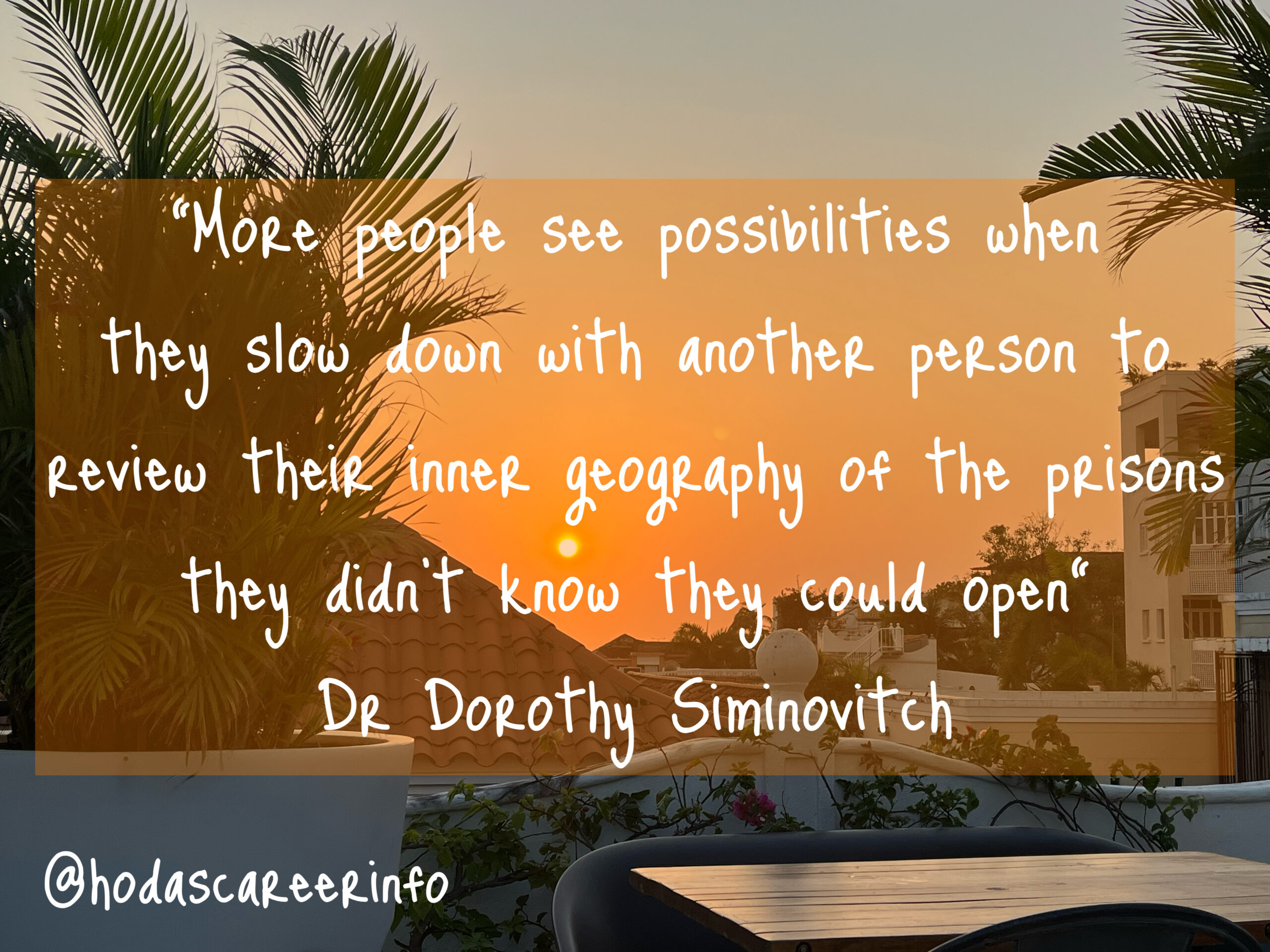If I am not for myself, who will be for me?
If I am not for others, who am I?
If not now, when?
– Hillel
A business client once told me she just did not have the time for the self-work that so deeply influences our actions and interactions, professionally and personally. I responded with understanding and compassion about the challenges of her life. But I also referenced the importance and positive impact of the work of Emotional Intelligence (by Goleman), Mindful Leadership (by SIYLI’s Chade-Meng Tan), and Awareness IQ (by Siminovitch). Many thought leaders and leadership experts agree that self-work—a commitment to reflecting on one’s values and inner world—is key for self-awareness, which influences what we choose to respond to and even how we will act. In more strategic language, our responses are “interventions” and are directly related to what we are aware of and the meaning we make from that awareness. Learning what shapes our awareness, and how to then use our awareness in ways that result in interventions that have impact and bring satisfaction, is why presence and use of self are such central concepts for coaches, consultants, and high performing leaders.
Masterful Intervention through Presence and Strategic Use of Self:
Tips and Tools
Presence is a critical topic, yet one that’s rather difficult to fully define and comprehend. Everyone has a presence that is unique to them. But coaches, consultants, and leaders need to understand and be aware of their presence: what one’s presence evokes in others, and how one’s presence can be strategically leveraged to provoke a change that is needed, wanted, or missing. We can learn about our presence, and become rooted in our strengths while being responsible for managing our limitations. This essential self-knowledge is what can be intentionally applied as “use of self.” When a person notices that something is needed, wanted, or missing, and then takes action on this awareness, that person has moved from an aware presence toward using himself to intervene, to provoke a change.

For more than 20 years, I’ve devoted myself to understanding, experientially teaching, and writing about presence and how to apply presence as masterful use of self. Along the way, I’ve found that people welcome tips and tools to orient themselves around the self-work of becoming more “present in their presence” and more self-aware in order to become a more effective intervener. So I offer here a few guidelines about what best supports that developmental self-work.
- Devote time to “centering” activities each day that contribute to strengthening the qualities of presence and self-awareness
- Identify your values and what you stand for. What creates imbalance for you?
- Appreciate the call to adapt, to be resilient, to innovate. Is there more you need or want to know to maintain a creative edge?
- Assess your emotional steadiness and your emotional range. Are you aware of the emotional triggers you need to manage?
- Consider how you are caring for yourself, as well as for others. Do you know when and how to set boundaries to protect yourself while still affirming compassion for others?
- Reflect on how you engage verbally with others. Are you communicating clearly and authentically?
- Scan your current situation and environment. Are you able to see both threats and opportunities? If not, what stops you?
- Learn to be in the present moment — travel light
Try not to carry cognitive baggage with you into the situation of the coaching or leadership encounter, e.g., knowing/not knowing, process/content, past/future tense. Significant changes are often best managed and effected through how we respond and act in the moment. Emergent somatic and verbal cues often tell us what’s needed, wanted, or missing. The ability to identify and surface these small pieces of “data” is a hallmark of successful use of self. When we are able, in the moment, to recognize the cues and respond appropriately, we experience a sense of satisfaction. When, instead, we missed the cues or perceived the call for a response but did not act, that failure of response is often experienced as a sense of regret, of lost opportunity.
Some have likened learning how to use the moment for both awareness and action as an art of improvisation (it’s also a bit like performing on the trapeze without a net). A good practice to strengthen being present in the moment is to do a closure audit following important meetings, sessions, or events. Ask yourself: What did I notice that felt important? Am I satisfied with my actions? Did my responses and actions support my values, or were they reactive and ungrounded? What will I practice doing next time? Learning to act appropriately and effectively in the moment is linked to being self-aware. Taking a closure audit is an act of learning awareness, strengthening one’s capacity to “read” the moment and to act on it. With practice, we become more comfortable knowing when and where we can be bold, and when and where to hold back. Acting in the moment reveals the integration of presence with use of self, and has the additional benefit of being experienced by others as “authentic.”
- Action is life: Perform and Be/Be and Perform
When you respond to or engage in a situation, are you doing so in a detached, “official” role, or in an observant, self-aware manner? Are you identifying and responding to the most compelling need or want of that moment? Do you wait for the right moment to emerge or the perfect action to present itself, and if so, does this hesitation result in missed opportunities and regret? How aware are you that even sharing an observation is itself an intervention? Whatever we say and do, including missing the cues of the moment, becomes an intervention. Can you use your presence to discern the compelling figure of awareness that allows you to make an intervention that matters?
I often tell a story of how I managed to intervene in a crowded group in a public pharmacy to get a woman a glass of water. Although she repeatedly asked for water, no one was assisting her. The pharmacist told her she needed to walk a great distance to another venue to get it. When I heard this, I made myself visible. I put myself in the pharmacist’s line of vision and gave him a non-verbal “look,” sending a somatic and emotional message of concern and outrage. Within a few seconds of seeing me, the pharmacist said, “Wait one minute. I’ll bring you some water.” Using one’s presence means to provoke the means of providing what is needed, wanted, or missing. In my story, all the woman needed was simply some water. Most of our interactions are so much more complex. Sometimes, though, all that’s necessary is recognition (do you see me?), or a few words of kindness (do you hear me?), or an invitation to try something or think something new that no one has yet offered. Using oneself as an effective intervener doesn’t mean you have to have direct access to all necessary resources. It means that you know how to mobilize the client system to get what is needed, wanted, or missing. This is why we say that compelling presence (of coach, consultant, or leader) assists and teaches clients to do something for themselves that they could not or would not do on their own.
Presence is a powerful tool. Its power remains a secret, for each of us, until we undertake the work of self-discovery. This self-work requires reflecting on our failures, learning our strengths, and integrating our multi-dimensional gifts of presence: our values, our creativity, our emotional astuteness, our heart-based relations with self and others, our ability to communicate clearly and movingly, our access to our intuitive knowledge, and our ability to read and understand the possibilities of our situation and environment.
I was very moved by this quote from Alan Turing, widely considered the founder of general purpose computers and so much more. Turing wrote: “Sometimes it is the people no one can imagine anything of who do the things no one can imagine.” I realized that I was moved by this powerful saying because it was not just true for so many of my clients, but also true for me. As a young adult, few thought much of or supported the possibility for my goals. Even when I’d realized those achievements, I still struggled to find the vehicle for my talents. What I learned was that I had to develop my own presence and use of self; I had to do the self-work that gave me the interior resources to move forward toward ambitious goals.
I envisioned Gestalt coaching as a professional field just as professional coaching itself was emerging, and this vision was my intuitive gift. I learned as well that even one’s gifts—our strengths—can intimidate or turn people away if those strengths seem too different. A colleague of mine calls this the Personal Weirdness Index (PWI): If we’re too similar to the client, she may feel too safe for us to evoke her interest; if we’re too different from the client, she may find us scary or “weird.” Our task as coaches, consultants, and leaders is to hold onto our gifts and strengths, but also to astutely manage our differences in relation to our clients and co-workers.
I did learn to invite and to involve others into my vision and my dream. I value those I work with who are willing to share their observations, inquiries, and feedback in ways that continue to help me develop. Without shared observations, questions, and feedback, I could not become more self-aware and more effective in my use of self. Presence is an interpersonal and group phenomenon, which is also why, in part, it attracts so much attention to its organizational and leadership relevance. Working well with others means that we resonate with others, and that resonance shows up when people are enjoying working with each other and being productive together.
In a world as globally connected and time-challenged as ours, presence and use of self are essential competencies that add value and hope to our every encounter with others. As a coach, consultant, or leader, your self-work is ongoing, because over time, you change, your situations change, your environments change. To become the coach, consultant, or leader you deserve to be, you need to stay aware of your presence and of how to use your presence in the moment when it is most needed. You need to have ongoing feedback and support about your presence and your use of self in order to deliver effective and satisfying interventions that make a difference.
Each of you has a light of excellence at the heart of your presence. And each of you has the potential to change someone’s life through your use of self. The opening quote from Hillel, from the ancient Sayings of the Fathers, continues to have meaning because it identifies that “presence” means being available to oneself, to others, and to the moment of need. Shine your light wherever you can to make a difference that matters to you and to your client, and that brings your client to a new level of self-awareness.

Dorothy Siminovitch with Jane Graydon, MBA, ATC




